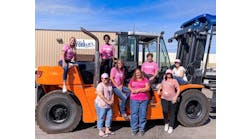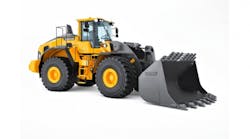The following has been adapted from Tim Whiteman and Dennis Eckstine's keynote address from the Aerial Platform Safety Conference in Dallas on November 4 and 5. Whiteman is president of Aerial Work Platform Training and managing director of the International Powered Access Federation, and Eckstine is executive vice president of AWPT.
The aerial platform industry is growing rapidly. The use of platforms is on an upward curve and hundreds of thousands of booms and scissors are currently in the field. In the United States, demand is on an upward trend and it is likely there will be 40,000 new platforms added to the market this year. In Europe, with about the same total number of inhabitants, only about 15,000 new platforms a year are entering the market. When Europe's economy recovers, it is likely that the number of new platforms bought each year will increase.
Typical platform users are electricians, plumbers, carpenters, steelworkers, photographers, cleaners, architects — anybody who needs to get up there to do the job. For the vast majority of users, a platform is simply a tool that reaches to the place of work and provides a stable base from which to do the work. A typical platform gets used by hundreds of people during its working life, so there are probably hundreds of thousands of new users being added every year. Why does the increasing number of users matter? Because everybody thinks that they know how to use an aerial platform. To a new user a platform looks like an easy tool to use — push this lever and it goes up, push this lever and it goes down. Seems easy, but it's not so simple.
Platforms should be easy to use, however, this strong selling point, this ease of use, can make people underestimate the real dangers of working at height. The easier to use a platform seems, and the more platforms in use, the more likely it is that the wrong people will use them. Unskilled personnel may not know the dangers of working at height, but are tempted to use a platform because it looks easy. These are the people who “borrow” a platform for two hours to reach a defective light or to fix a piece of piping that got knocked earlier in the day. These are the same people who do the things that can result in tragic accidents. If these people are working on a busy site and are not stopped, they are a danger to themselves and to the others on site.
Results of untrained operators using platforms on site can be tragic and expensive. Studies show that a major cause of accidents in this business is operator error. This is assuming that the machine has been well maintained and is delivered to a reasonable and safe working condition. Operator error generally means that an operator has been inadequately trained. IPAF and AWPT have launched a project to collate accident reports and statistics. This project is in its early stages and will take years to produce comprehensive results, but the trend points to operator error being the most common cause of accidents.
In some cases the cause of accidents is machine failure, but research suggests that this is rare. It also suggests that in some cases the description of machine failure may be misleading. IPAF performed a detailed analysis of accidents recorded by the United Kingdom's Health & Safety Executive, its equivalent of OSHA. This revealed that accident summaries could be inaccurate or confusing. An example of this was a case in which a platform was reported to have collapsed — closer investigation revealed that the ground gave way beneath an outrigger. Should this really be listed as machine failure?
What is the solution? How do we stop potential platform operators from unknowingly, and unintentionally, becoming a danger to themselves and their colleagues? Should manufacturers be making the platforms more difficult to operate, or making them look more dangerous?
Certainly not. In fact, manufacturers should continue to simplify and improve control systems with the specific aim of making it even more difficult to have an accident. The only solution is to insist that anybody using a platform prove that they have been trained in the safe use of aerial work platforms. Everybody using a powered access platform to do a job should be asked to prove that he or she has been trained in the use of that equipment.
Proper training does not mean a 10-minute handover at the moment the key is collected. It means thorough training in a small class, lasting about a day, in the general use of aerial work platforms. This “primary” training should cover everything from the dangers of potholes to the basic use of safety harnesses, the effects of wind, the dangers of overhead cables, to checking the machine and preparing to use it. A proper understanding of directly relevant legislation should be included in this primary training.
There should also be a familiarization when a new machine is delivered. This is the time when the operator finds out where the controls are on a new machine and learns about any features that are specific to that machine, such as the emergency lowering system or the button that tilts the basket. The generic primary training will have taught the operator what information to look for during the handover.
IPAF's members have developed a training program created by a group of manufacturers and users as a result of direct pressure from the U.K.'s HSE. IPAF's members decided that the courses for basic machines should not take longer than one day, should be held in small classes, should involve a mixture of theory and practice and include a test. The result is that the training is affordable, can be done quickly and is hugely successful. This is essentially the same training program that AWPT offers in North America, but here it is adapted to ensure compliance with all relevant ANSI and OSHA requirements. Training is not given by AWPT or IPAF, but is given by companies that become AWPT training centers after meeting the stringent requirements. They then deliver the AWPT training to quality standards.
IPAF and AWPT are both not-for-profit membership organizations that are dedicated to promoting the safe and effective use of platforms worldwide. Membership of the 21-year-old IPAF is open to any person or organization working with powered access. It includes rental companies as well as all the major manufacturers of platforms worldwide. AWPT is a U.S. subsidiary and provider of training services. Members believe that encouraging large numbers of operators to get trained is one of the most effective ways of promoting the safe and effective use of platforms — we do not want accidents in this industry.
Almost as important as the training is proof of training. Those who pass training receive a card that provides a quick and easy way of proving that an operator has been trained.
The training program is not exclusive. It is an industry attempt to provide a minimum standard for operator training that meets internationally accepted standards such as ISO 18878. Many of the training centers continue to offer their own training programs alongside the PAL Card (Powered Access Licensed-Registration) program and might also offer courses on maintenance or advanced operator training. Typically training centers are operated by rental companies or manufacturers. Currently about 40,000 people a year are qualifying to hold a PAL Card and, as well as English, training is given in German, Dutch, Italian, French, Spanish and Portuguese.
Training matters and will make a vital contribution to safety. As the number of platforms in use increases, it is vital that it becomes “the norm” that operators are trained. Untrained personnel should not touch aerial work platforms. Even the most “macho” of young men are interested in self-preservation. A good training program presented by a knowledgeable instructor teaches aerial platform users their limits and to know when they are doing something life threatening. And if anybody ever questions the costs associated with operator training, the simple answer must be, “If you think safety is expensive, try an accident.”
Contact Tim Whiteman in Switzerland at 011 41 61 225 4410 or e-mail him at [email protected]. Dennis Eckstine can be reached at (717) 762-1911 or e-mail him at [email protected]. Visit www.ipaf.org for more information.


